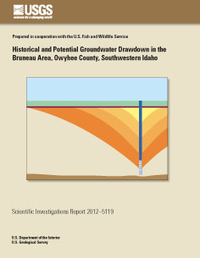Geothermal seeps and springs in the Bruneau area in southwestern Idaho provide a vital but disappearing habitat for the Bruneau hot springsnail (Pyrgulopsis bruneauensis). In order to aid in conservation efforts, a two-part study was conducted (1) to determine trends in groundwater levels over time and (2) to simulate drawdown in aquifers that contribute to the geothermal seeps and springs along the Bruneau River. Seasonal and Regional Kendall tests for trends were used to determine water-level trends over a 20-year monitoring (1990–2010) period. Seasonal Kendall tests were used to calculate trends in groundwater-levels in 22 monitoring wells and indicated statistically significant changes in water level with trends ranging from 0.21 to 1.0 feet per year. Regional Kendall tests were used to calculate drawdown in categories of wells based on five criteria (well depth, distance from Indian Bathtub Spring, geologic unit, regional topographic valley, and temperature). Results from Regional Kendall tests indicate that slope of the trend (in feet per year) increased as a function of well depth; trends in water level as a function of other categories did not exhibit an obvious pattern based on distance from Indian Bathtub Spring, geologic unit, topographic valley, or temperature. Analytical solutions were used to simulate drawdown and recovery in wells using the Theis equation and a range of hydraulic parameters. Drawdown effects were determined by changing the storativity, transmissivity, and flow values over a hypothetical timeline. For example, estimates projected that after 20 years of pumping (at an assumed storativity of 0.002, a transmissivity of 980,000 feet squared per day, and a flow of 100 acre-feet per year), 1 foot of drawdown in the volcanic-rock aquifers would not be detected; however, other estimates using the same time frame but different hydraulic parameters (storativity of 0.001, transmissivity of 13,000 feet squared per day, and 610 acre-feet per year) determined 1 foot of drawdown to be detected as far as 29 miles from the hypothetical pumping well. A sensitivity analysis was performed to determine the effect of changing one hydraulic parameter while keeping the others constant. Many assumptions had to be made about properties of the aquifer in order to calculate effects of drawdown on geothermal seeps and springs. These analyses estimate pumping effects over time; the recovery of groundwater levels would likely take significantly longer to observe than the effects from pumping.


